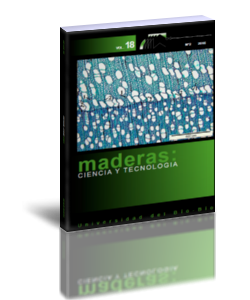Differences in dynamic modulus of elasticity determined by three vibration methods and their relationship with static modulus of elasticity
Keywords:
Acoustic, density, dynamic MoE, MoR, static MoE, ultrasonic.Abstract
Dynamic modulus of elasticity was determined in clearwood samples of eight tropical hardwood species using longitudinal vibrations, flexural vibration and ultrasonic transit-time methods. These samples were subsequently subjected to three point static bending test to determine static modulus of elasticity and modulus of rupture. Acoustic velocity and wood density were found to be independent parameters as the velocity was nearly the same in wood with distinctly different densities. Among the three dynamic measurements, modulus from the ultrasonic method was the highest followed by the longitudinal vibration and flexural vibration. Any of three vibration methods could be used to predict static modulus as they exhibited a near perfect correlation with static MoE. However, the dynamic modulus determined by different vibration methods were found to diverge with increasing static modulus. Wood density was the dominating factor influencing both modulus of elasticity and modulus of rupture.Downloads
Download data is not yet available.
Downloads
How to Cite
Chauhan, S., & Sethy, A. (2016). Differences in dynamic modulus of elasticity determined by three vibration methods and their relationship with static modulus of elasticity. Maderas. Ciencia Y Tecnología, 18(2), 373–382. Retrieved from https://revistas.ubiobio.cl/index.php/MCT/article/view/2382
Issue
Section
Article

































